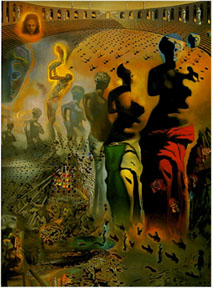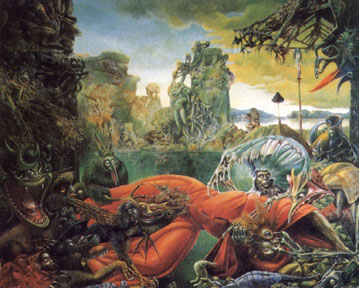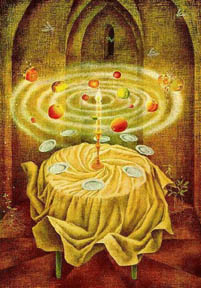.
Surrealism

Max Ernst
|
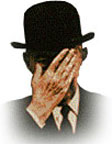
Rene Magritte
|

Salvador Dali
|
The artistic style of surrealism
began as an official movement shortly after the end of the first world war.
In its infancy, it was a literary movement, but soon found its greatest
expression in the visual arts. In general, the style focuses on psychological
states which resemble dreams and fantasy. The artists were influenced by
psychological research of Sigmund Freud and Carl Jung, who sought to explain
the workings of the mind through analysis of the symbols of dreams. Instead
of using psychoanalysis to cure themselves of any disturbances, the surrealists
saw the unconscious as a wellspring of untapped creative ideas. "A dream
that is not interpreted is like a letter that is not opened" is a famous
quote from Freud. The surrealists were less interested in interpretation
of their dream symbols than they were in the expressive capacity of such
states.
The surrealists admired the artwork
of the insane for its freedom of expression, as well as artworks created
by children. They admired previous artists such as Henri Rousseau, whose
naive and self-taught works always contained an element of surreal fantasy.
In addition, they looked for inspiration from masters of the Renaissance
such as Hieronymous Bosch and Pieter Brueghel, whose fantastic elements
can easily be described as surreal. The word "surreal", in fact,
means "above reality". In other words, the artists believed that
there was an element of truth which is revealed by our subconscious minds
which supercedes the reality of our everyday consciousness.
There are actually two branches
of surrealism. One group focused on creating realistic representations of
dream-like states; the other preferred an abstract style. For now, I will
focus on three masters of representaional surrealism.
Salvador
Dali
(Spanish, 1904-1989)
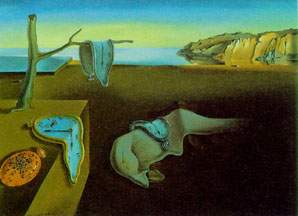
The Persistence of Memory 1931
|
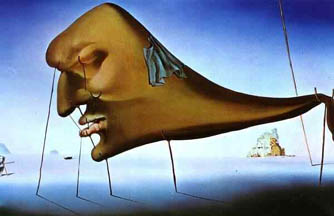
Sleep 1937
|
Salvador Dali is, without doubt,
the most famous member of the surrealist group. His painting, The Persistence
of Memory almost stands alone as a symbol of the movement. The melted
clocks represent the strange warping of time which occurs when we enter the
dream state. The stretched image of a man's face which is at the center of
the painting is believed to be that of Dali himself, and the landscape which
stretches out behind the scene may perhaps represent his birthplace, Catalonia.
Dali's painting of Sleep is also successful in its suggestion of the
precarious balance of sleep. We realize that if a single crutch were to fall,
the dreamer will awake.
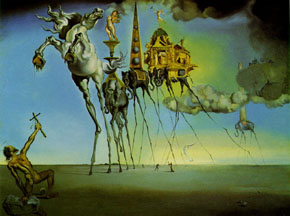
Temptation of St. Anthony
|
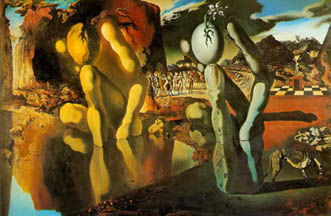
Metamorphis of Narcissus 1937
|
Dali frequently made reference to
themes which have been repeated throughout the history of art. The Temptation
of St. Anthony was a theme frequently taken up by some of the more fantasy-oriented
Renaissance artists (Matthais Grunewald, for example). In Dali's version,
the saint has been walking through a desert when he is confronted with a monstous
horse and a team of elephants on stilt-like legs. There are also images of
sexuality which the saint must oppose, using his cross to ward off the vision.
The Metamorphosis of Narcissus plays on the classical theme about a
beautiful young man who admires his own reflection in a pool of water. Transfixed
by his own beauty, he turns to stone. Always the master of illusion, Dali
creates a double-image, where the boy's form is repeated as an enlarged hand
holding an egg which bursts forth with a narcissus flower.
|
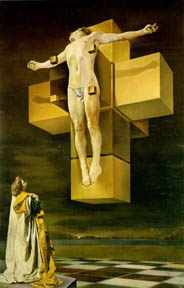
Crucifixion 1954
|
The Hallucinogenic Torreador is perhaps Dali's most successful painting involving multiple hidden images.
A complete analysis of the painting would be a complex undertaking. It primarily
focuses on the torreador (bull-fighter), whose face is hidden within the
repeated representation of the Venus de Milo. The upper portion of the painting
contains the bull-fighter's arena, again surrounded by multiple images of
the goddess. There is also a hidden image of the bull in the lower left
quadrant of the painting (drinking water from a pool), and an image of a
boy (possibly a self-portrait as a child, as his clothing represents the
approximate time period of his boyhood). The Crucifixion is another
powerful painting. The innovation of a floating cross which intersects Christ's
body gives an illusion of another dimension. A shocking aspect of this painting
is that the representation is believed to be a self-portrait. The single
figure who stands in adoration is believed to be that of his wife, Gala
(who often appeared in his paintings).
Dali was very prolific throughout
his life, creating hundreds of paintings, prints, and even sculptrues. He
also produced surrealist films, illustrated books, handcrafted jewelry,
and created theatrical sets and costumes. His frequently odd and shocking
behaviors also contributed to his fame. One only needs to look at his photo
(with his long waxed mustache and crazed look) to know that he was a bit
beyond eccentric. He was actually denounced and "excommunicated"
by the leader of the movement (Andre Breton, a French poet), who felt that
he had become too commercial and that his staged events were merely put
on to bring attention to himself. There is no doubt that he thought much
of himself, as he titled his autobiography "Diary of a Genius".
Despite his shameless self-promotion, the meticulous draftsmanship and realistic
detail of his paintings ranks him as a master, whose subject matter makes
him a great modern painter.
Rene
Magritte
(Belgian, 1898-1967)
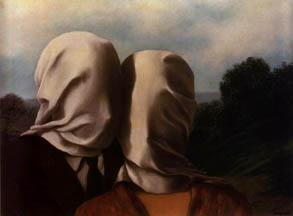
The Lovers 1928
|
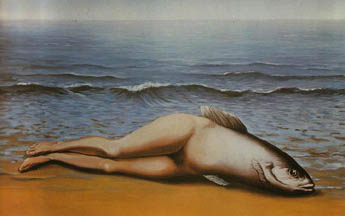
Collective Invention 1934
|
Another
member of the surrealist group whose
works have become synonymous with the movement was Rene Magritte. This Belgian
artist's temperment was opposite to that of the flaming eccentricity of Dali.
He lived a quiet and "normal" life, married only one woman, and
was very much a middle-class working man. Though connected to the movement,
he separated himself from any the less provincial activities - preferring
to work at home (in his dining-room, in fact!). Despite his seeming bougouise
lifestyle, his works are extraordinary in their sense of fantasy and surreal
reality. The Lovers may be a visual depiction of the idea "love
is blind". I personally interpret it as the mystery that veils our understanding
of a lover, who is never completely known to us. Collective Invention may be a play on the image of a mermaid. If a woman can have fins for legs,
why not an inverted version?
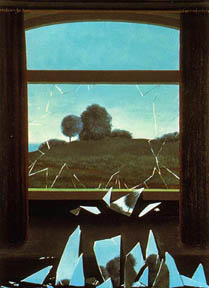
Cle de Champs 1931
|
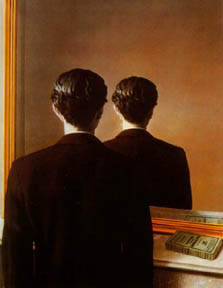
Portrait of Edward
James 1937
|
Magritte constantly challenged our preconceptions about reality. His works
contain extraordinary juxtapositions of ordinary objects or an unusual context
that gives new meaning to familiar things. He often used the window frame
as a suggestion of the illusion of our senses, for a painting in itself
has been traditionally used as a window on some other world- as if we could
look through the flat surface of a canvas to a three dimensional reality.
The idea of a man looking into a mirror to see the back of his own head
also plays upon our normal expectations (the man is the young Edward James,
once the world's largest collector of surrealist art, and a friend to Magritte).
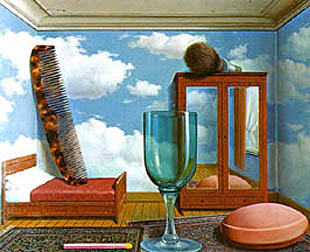
Personal Values 1951
|
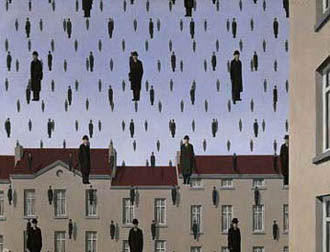
Golconde 1953
|
By altering
the scale of objects in his paintings, Magritte's work gives an immediate
sense of surreal absurdity. Everyday objects become magical in his painting, Personal Values. In Golconde, Magritte paints himself in endless repetition.
In trench coat and bowler cap, he becomes a symbol for "everyman",
perhaps commenting on the anonymity of city life.
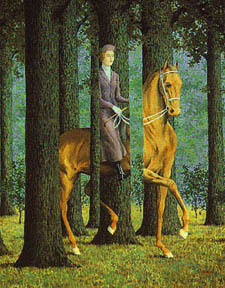
Carte Blanche 1965
|
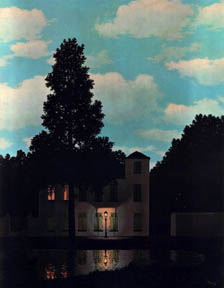
Empire of the Lights 1954
|
Magritte constantly challenges
our sense of time and space. In Carte Blanch, he manipulates the
space so that we have an illusion of a woman and horse who are simultaneously
in front of and hidden by trees (even hidden behind the empty space between
trees). Empire of the Lights is more subtle in its playfulness. It
may take a moment for viewers to realize that the daytime sky does not fit
the lighting situation of the night scene below. His cunning creativity
places Magritte as one of my favorite artists of all time.
Max
Ernst
(German, 1891-1976)
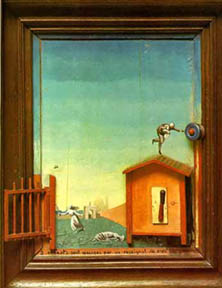
Two
Children Frightened By a Nightingale
|
|
Max Ernst
was one of the founding members of surrealism, who had previously been linked
to the dada movement. Born in Germany, he practiced mainly in France, and
fled Europe during the occupation of the Nazis (as did Dali and many other
artists throughout Europe). During his career,he invented several methods
which were instrumental to the surrealists. One new method he explored was
"frottage", which involves making
rubbings of textured surfaces, using the marks as chance starting points
for an image. He also invented a similar technique called "decalcomania",
which involved painting on glass and then pressing it directly onto the
canvas to create a texture. This allowed his subconscious mind to see into
the random pattern, thus creating images directly from his imagination,
without any preconcieved ideas. His paintings contain an element of magic,
and sometimes terror. Two Children Frightened By a Nightingale is
one of his most famous images, and perhaps one of the first paintings to ever combine 3-D elements into the
2-dimensional space. The Temptation of St. Anthony is yet another version
of an image about the tortured saint. Created just after the end of WWII,
I think that it may be also be comment about the monstrousities of war.

Robing of the Bride 1940
|
|
Women of Surrealism
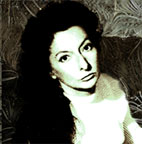
Remedios Varo
|
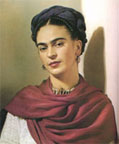
Frida Kahlo
|

Leonora Carrington
|
Though surrealist
painters admired women to a degree of near-worship, they were seen more as
a muse to their own creativity instead of creative masters in their own right.
The three women above were surrealists in every sense of the word, but were
not an integral part of the surrealist movement, which was active especially
in Paris. All three of these women lived and worked in Mexico, though Kahlo
was the only one of the three who was born there. The others escaped from
Nazi occupation throughout Europe by traveling to Mexico. They and several
other artists began a small tangendental surrealist movement. Their works
continue to influence modern painters in Mexico who work in a fantasy-oriented
vein.
Remedios
Varo
(Spanish,1912- 1970)
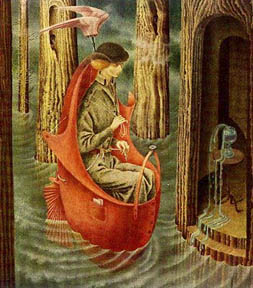
Exploring Rio Orinico 1959
|
|
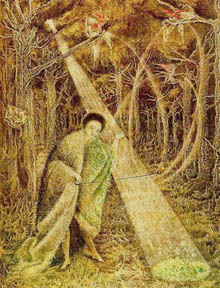
Solar Music 1955
|
Remedios Varo, born in Spain,was
the daughter of a devout Catholic mother and a scientist father, an atheist.
Her mother's mystical leanings fed her supernatural imagination, but her
father's emphasis on science and reasoning would have an equal influence
on her life and works. Her father gave her lessons in drawing two-point
perspective and technical drafting. Ê Her mother enrolled her in a convent
school but she fled in 1924. She soon attended an art academy in Madrid,
where she met Salvador Dali. She later moved to Paris and developed connections
with the surrealists movement there. Ê Although she won their admiration
she did not consider herself a Surrealist. Instead of involving chance elements
in her compositions, she strove for complete control.
While the Nazis
were marching across Europe, she boarded a steamer and embarked on the long
voyage to Mexico. It is here that she developes a style which is uniquely
her own. She painted fantastic images in which the spiritual is entwined
with the scientific as though trying to find the common ground between metaphysical
and the machine. ÊIn her final work, Still Life Reviving, she paints
a metaphor of the cosmos where fruits represent planets revolving around
a candle flame. The fruit splits open and scatter their seeds upon the ground
where they sprout as new life and hint of rebirth out of chaos. One month
later, Remedios died at the age of 55 of a massive heart attack. She is
highly regarded in Mexico (where her numerous retrospectives have drawn
record crowds), but remains virtually unknown in the United States and Europe.
Leonora
Carrington
(English, b. 1917)
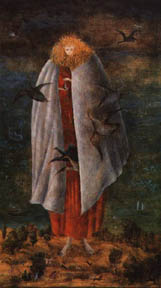
The Guardian 1950
|
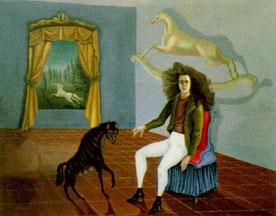
Dawn Horse (Self Portrait) 1936
|
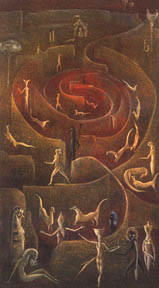
Ferret Race 1950
|
Leonora Carrington was very similar
to Varo's in many respects. Born in England to a wealthy family, Leonora
learned at a very early age the injustice of society. Since her parents
were both very strict Catholics, they sent her away from convent to convent
and then to boarding school. The young Leonora was was a debutante, a girl's
school rebel and a runaway. After running away from home to become an artist,
she met Max Ernst, who left his wife for Carrington. The couple lived together
until the outbreak of WWII, when Ernst (a German citizen) was taken prisoner
as an enemy alien. She tried in vein to have him released, then suffered
a nervous collapse. For a short time she was put in a mental institution
(at the order of her family), was given sedative drugs, but soon escaped.
She married a friend who protects her from further incarceration. After
moving to Mexico, they soon divorce ( the marriage is no longer necessary,
but they remain friends). She remarries, has a couple of children, and continues
to paint surreal visions combining mythological stories and childhood fantasies.
She also wrote incredible, surrealist stories (which later become published
and achieve critical acclaim). While in Mexico, she developed a life long-friendship
with Remedios Varo. She also befriends Edward James, the eccentric English
millionaire who collected her art (he was also the incredible architect
of Las Pozas, in the rainforest of Mexico).
As far as I know, she is still alive and painting. Like Varo, she is also
more famous in Mexico than in America or Europe.
To view the surrealist artworks of Frida Kahlo, go to
the next page,
which also includes works by her social realist husband, Diego Rivera
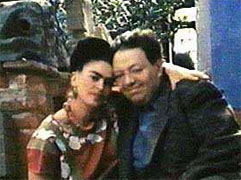
Next: Frida Kahlo y Diego Rivera
|








